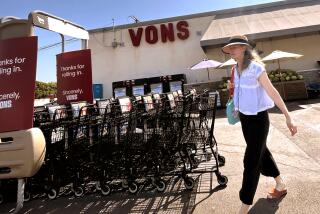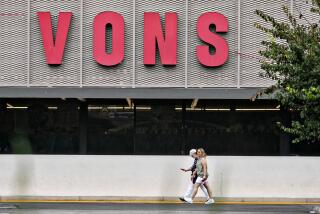Buy-Out Completed : New Vons Ownership Sold on Super-Stores
- Share via
Roger E. Stangeland, chairman and chief executive of Vons Grocery Co., comes from a family of meat cutters. His father and grandfather were butchers, as were his father’s 17 uncles, all of whom had shops in a Scandinavian section of Chicago known as Andersonville. Stangeland uses his grandfather’s original butcher block in the kitchen of his San Marino home.
So he views with some irony the fact that the union representing meat cutters in Southern California chose Vons as its main picketing target in the bitter, two-month strike that ended last week. The strike was supported by about 3,500 of 15,000 workers employed by El Monte-based Vons’ 180 stores.
‘Delighted They’re Back’
Stangeland (pronounced stang-land) acknowledges that the strike had a serious effect on the company’s sales, although he declined to estimate its financial impact. “We’re delighted they’re back,” Stangeland said.
The labor dispute concluded at a fortuitous time for Stangeland, 56, and a group of other private investors, who on Friday pounded the final nails in a deal to buy Vons’ parent, Household Merchandising, from Household International. Agreements to sell Household Merchandising’s three other retailing units are expected to be completed soon, leaving Vons the only operation in the company.
And that’s “where we wanted to be when we started” the buy-out process in May, Stangeland said in an interview last week.
Longer-Term Issues
With Vons in a pitched battle against Ralphs for highest market share in competitive Southern California, Stangeland said he believes the company is in a better position to “concern ourselves with longer-term issues than quarterly results” now that it is out from under Household International’s corporate umbrella. As a private company, Vons is not required to report results.
“Our intent from the beginning was to simplify the company,” said Stangeland, who spent much of Thursday night signing documents relating to the buy-out at the downtown Los Angeles offices of Security Pacific National Bank, which is providing financing for the deal. “We thought it was almost too good to be true to complete the divestments simultaneously with the closing. Our goal was to end up with a company not encumbered with enormous debt.”
The companies being sold are T.G.&Y.;, an unprofitable chain of general stores in 26 states, and two franchise operations--Coast-to-Coast hardware stores and Ben Franklin variety stores. Proceeds from those sales will be used to pay off most of the bank debt incurred in the purchase by the acquiring company, HMI Holdings.
The amount paid to Household included $520 million in cash, $125 million in notes and an equity interest worth $8.4 million in the acquiring company. In addition, HMI paid off $70 million in maturing notes and paid Household a $50-million dividend. HMI Holdings, which agreed to buy Household Merchandising in October, is owned by a group of investors led by Donaldson, Lufkin & Jenrette and Bass Investment Limited Partnership.
Vons has embarked on a program of “orderly, consistent” growth and expects to pass the 200-store mark in 1988, said Stangeland, who came to Vons just over a year ago after being an executive vice president at Household Merchandising. “We will have been closing small stores and opening big ones and, more important, taking conventional stores” and remodeling them into variations of the company’s Pavilion concept.
The first Pavilion store opened in October in Garden Grove and “is performing better than our ambitious expectations,” Stangeland said. The store has more than 70,000 square feet, making it two to three times larger than a conventional store. It is geared to balancing value with quality, service, selection and what Stangeland, a gourmet cook, calls “food fashion.”
Moving Toward Larger Stores
As competition has intensified, supermarket chains have gravitated toward larger stores--40,000 square feet or more--to try to win new customers by providing more diverse services. The top three grocers in the Southern California market--Lucky, Vons and Ralphs--have jockeyed for position this year by advertising price and image as well.
Anthony Ludovici, vice president and senior investment analyst at Tucker, Anthony & R. L. Day in New York, said Vons management “has demonstrated an ability to compete. They have a track record that indicates they’re aware of the markets they serve.”
Among Vons’ competitors in Southern California are Gelson’s and Irvine Ranch Market, stores with emphasis on produce, prepared foods, fish and specialty food items that appeal to higher-income consumers.
Some of the Pavilion’s features address this competition. There is a deli with a large in-store kitchen that daily produces salads and such specialties as duck with raspberry sauce and beef Wellington. The kitchen is managed by a graduate of France’s Cordon Bleu cooking school.
The Pavilion’s European-style fish cases are unrefrigerated except for the ice on which the fish is laid. Refrigeration tends to draw out the fish oils, which become trapped and cause odors, Stangeland explained.
In the store’s bakery, bread, rolls and croissants are made fresh daily in ovens with glass fronts so that customers can observe the process. The recipes were developed with a consultant from Belgium. Shoppers can also see meat being cut, boned and trimmed for Vons’ own sausage, which is smoked on the premises. There is also a fresh juice and melon bar, a tortilleria where fresh tortillas are made day and night, and a floral department with a floral arranger on duty. The store has “great animation,” Stangeland said. The Pavilion also includes a large health and beauty aids section and a pharmacy.
Upscale Appeal
Despite the store’s apparent upscale appeal, Stangeland contends that nothing is priced as an “elitist item.”
“We have commitments to low prices on the basics,” he said. “We believe that people of a broad number of economic strata will be driven by quality, service, selection and value and therefore will want to shop at a store that offers variety and prices.” He expects on any given day to see “pickup trucks and Cadillacs” parked side by side in the lot.
Stangeland said Vons’ management team set out a year and a half ago to develop “a second-generation food and drug store that was significantly better than elsewhere.” Unable to find a good role model in Southern California, they traveled throughout the United States, Canada and Mexico, picking up ideas as they went.
Even so, Stangeland said, there are no “absolute knockoffs” of other grocers’ concepts in the Pavilion store. “Retailers are all copycats, but they can copy too late and it’s obsolete,” he said.
Stangeland, an avid hunter, likens such tardiness to a duck hunter who aims at the lead bird but shoots the last one. “We’re determined not to do that.”
More to Read
Inside the business of entertainment
The Wide Shot brings you news, analysis and insights on everything from streaming wars to production — and what it all means for the future.
You may occasionally receive promotional content from the Los Angeles Times.











